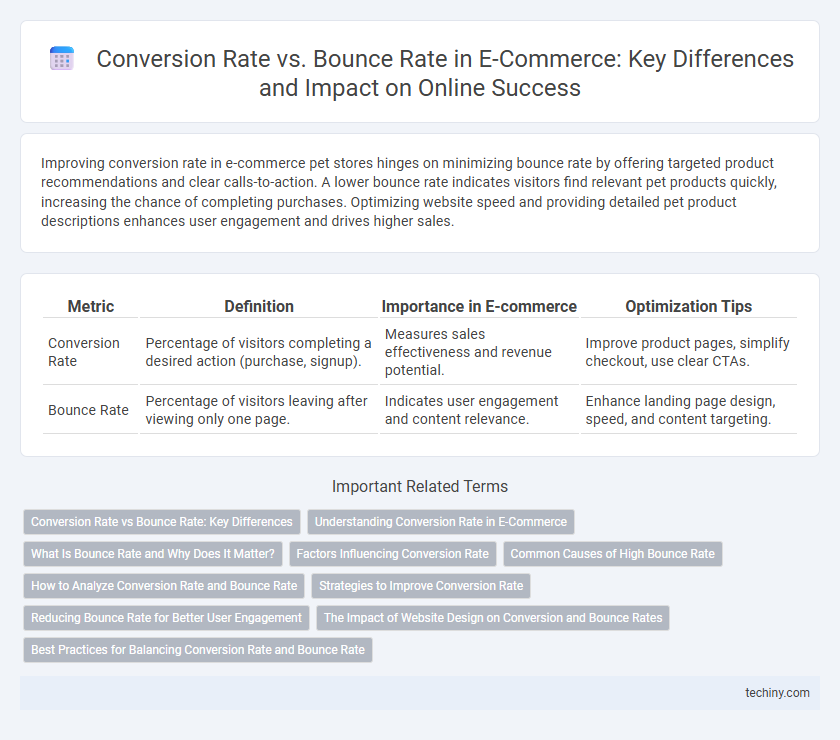Improving conversion rate in e-commerce pet stores hinges on minimizing bounce rate by offering targeted product recommendations and clear calls-to-action. A lower bounce rate indicates visitors find relevant pet products quickly, increasing the chance of completing purchases. Optimizing website speed and providing detailed pet product descriptions enhances user engagement and drives higher sales.
Table of Comparison
| Metric | Definition | Importance in E-commerce | Optimization Tips |
|---|---|---|---|
| Conversion Rate | Percentage of visitors completing a desired action (purchase, signup). | Measures sales effectiveness and revenue potential. | Improve product pages, simplify checkout, use clear CTAs. |
| Bounce Rate | Percentage of visitors leaving after viewing only one page. | Indicates user engagement and content relevance. | Enhance landing page design, speed, and content targeting. |
Conversion Rate vs Bounce Rate: Key Differences
Conversion rate measures the percentage of visitors who complete a desired action, such as making a purchase, while bounce rate tracks the percentage of visitors who leave the site after viewing only one page. A high conversion rate indicates effective user engagement and successful sales funnel optimization, whereas a high bounce rate suggests potential issues with site relevance or user experience. Understanding the key differences between conversion rate and bounce rate helps e-commerce businesses optimize marketing strategies and website design to boost sales performance.
Understanding Conversion Rate in E-Commerce
Conversion rate in e-commerce measures the percentage of visitors who complete a desired action, such as making a purchase, out of the total site traffic. A high conversion rate indicates effective marketing strategies, user experience, and product appeal, directly impacting revenue growth. Analyzing conversion rate alongside bounce rate helps identify areas for optimization, ensuring more visitors transition from browsing to buying.
What Is Bounce Rate and Why Does It Matter?
Bounce rate represents the percentage of visitors who leave an e-commerce site after viewing only one page, indicating a lack of engagement with the brand or product offerings. A high bounce rate can signal issues such as slow website speeds, poor user experience, or irrelevant content, which directly affect conversion rates by reducing potential customer interactions. Monitoring and optimizing bounce rate is critical for e-commerce businesses aiming to improve user retention and increase sales performance.
Factors Influencing Conversion Rate
Conversion rate is heavily influenced by website usability, including fast loading times, clear navigation, and mobile responsiveness, which reduce bounce rates and improve user engagement. High-quality product images, detailed descriptions, and customer reviews build trust and encourage purchase decisions, directly boosting conversion rates. Effective call-to-action buttons strategically placed throughout the site guide visitors toward completing transactions, increasing overall e-commerce profitability.
Common Causes of High Bounce Rate
High bounce rates in e-commerce often stem from slow website loading times, poor mobile optimization, and confusing navigation. Ineffective product descriptions and lack of clear calls to action contribute significantly to visitors leaving without engaging. Addressing these issues improves user experience and increases the conversion rate by keeping potential customers engaged.
How to Analyze Conversion Rate and Bounce Rate
Analyzing conversion rate involves tracking the percentage of visitors who complete desired actions such as purchases or sign-ups, using tools like Google Analytics to segment data by traffic source, device, and user behavior. Bounce rate analysis requires measuring the proportion of visitors who leave after viewing only one page, identifying patterns in landing pages and site speed to determine user engagement. Correlating these metrics helps e-commerce businesses optimize site design and marketing strategies for improved customer retention and sales performance.
Strategies to Improve Conversion Rate
Improving conversion rate in e-commerce involves optimizing website user experience, such as streamlining navigation, enhancing page load speed, and providing clear calls-to-action. Implementing personalized product recommendations and leveraging targeted email marketing campaigns significantly increase customer engagement and purchase likelihood. Analyzing bounce rate data helps identify weak landing pages, informing A/B testing to improve content relevance and reduce visitor drop-off.
Reducing Bounce Rate for Better User Engagement
Reducing bounce rate in e-commerce significantly improves user engagement by keeping visitors on the site longer and encouraging them to explore more products. Effective strategies include optimizing site speed, enhancing mobile responsiveness, and offering personalized product recommendations. Lower bounce rates lead to higher chances of conversions, as engaged users are more likely to complete purchases and return for future shopping.
The Impact of Website Design on Conversion and Bounce Rates
Effective website design directly influences e-commerce conversion rates by enhancing user experience through intuitive navigation, fast loading times, and mobile responsiveness. Poor design elements increase bounce rates as visitors quickly leave sites that appear cluttered, confusing, or slow. Optimizing layout, visuals, and call-to-action buttons significantly reduces bounce rates while boosting conversions and overall sales performance.
Best Practices for Balancing Conversion Rate and Bounce Rate
Optimizing conversion rate while minimizing bounce rate requires clear, concise calls-to-action and user-friendly website navigation tailored to customer intent. Implementing fast load times, high-quality visuals, and relevant content ensures visitors engage meaningfully rather than leaving immediately. Regular A/B testing and data analysis reveal customer behavior patterns, enabling targeted improvements that balance conversions with user retention.
Conversion Rate vs Bounce Rate Infographic

 techiny.com
techiny.com